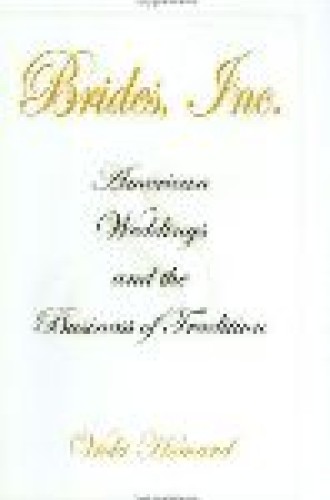Weddings, Inc.
With divorce, cohabitation, civil unions and gay marriage stretching people’s understandings of marriage, one might expect that the rite of entrance to marriage—the wedding—would also be changing or dwindling toward irrelevancy.
One might think that—unless one has attended a wedding recently. Or stood in a supermarket aisle and observed the expanding rack of bridal magazines. Or heard that the average cost of a wedding is nearly $30,000—and has doubled since 1990. Even if those numbers are inflated—which is likely, since they are reported by a publisher of bridal magazines and benefit the industry by normalizing massive wedding budgets—they point to the trajectory of the modern American wedding.
Three recent books scrutinize the $80 billion wedding industry. Vicki Howard offers a historical survey of the business of weddings; Rebecca Mead provides a journalistic account of the contemporary wedding scene; and Colleen Curran collects women’s stories about weddings. Although none of the writers is equipped to counsel pastors, all of them detail the way in which commercial interests have stepped into what Mead calls the “vacuum of authority” regarding how people should marry. And all of them point to small but promising signs of a movement toward nuptial common sense that questions a climate in which a $15,000 wedding is regarded as frugal.
The wedding industry—that cluster of corporations and individuals that provides products and services to brides and grooms and hopes to hook them as customers for life—is less frequently a target than are the minutiae-obsessed modern brides themselves, also known as “Bridezillas.” They’re the women who throw tantrums if the reception punch doesn’t match the place cards, who make their attendants show up for ten fittings, and who weep if none of the guests remortgage their house to buy the silver tableware on the gift registry. Bridezilla is a figure of such mythic proportions that bridal magazines and Web sites themselves are dishing out advice about how not to be one—which journalist Anne Kingston, in The Meaning of Wife, says is “not unlike a drug dealer expressing worry that his customers might end up addicted.” And while many women of marrying age have at least one story of a friend-turned-wedding-monster, Mead writes that the now fashionable derision of Bridezilla “provides a way to separate off, into safe quarantine, the disconcerting sense that the way we conduct weddings has somehow gone wrong. . . . The Bridezilla caricature is a stand-in representing a much larger anxiety: that we are all living in a Bridezilla culture.”
Many of the writers in Curran’s collection confess to Bridezilla tendencies. “Before I knew it, I was spending all my free time thinking about wedding favors and invitations, centerpieces and bridal registries, cakes and photographers,” writes film critic Carina Chocano in Altared. “And slowly but surely, our wedding took on all the characteristics of a Martha Stewart photo spread. . . . I’d fallen for all of it, like a sucker.”
The “I-wanted-a-simple-wedding-but-ended-up-with-the-cathedral-train” theme is so prevalent in Curran’s book as to render the voices of the authors almost indistinguishable. While Curran’s attempt at diversity is obvious (one essay is by a lesbian, several are by non-white writers, and at least one is written by a thrice-married “encore bride”), and while the authors subscribe to a range of opinions on what constitutes a meaningful wedding, the essays tend to merge into one witty, young-hip-and-urban and mostly forgettable voice. The book does serve as a visual aid for the other two books reviewed here—a flannel graph, of sorts, on which the storyline of modern weddings is performed. But rather than critically engaging the meaning of the wedding or the consumer rites that have sprung up around it, the book seems designed to give brides-to-be a little of the prewedding self-care that the industry itself so champions. Indeed, like many of the proliferating “antibride” and “indie-bride” manuals and Web sites, it seems less about critiquing the frenzy surrounding modern weddings than about participating in it.
Howard traces the growth of wedding-related entrepreneurship involving rings, gowns, consultants and catering services. She demonstrates “how the commercial became the cultural—how the rise of consumer capitalism transformed one of life’s most significant, intimate moments.” Using historian Eric Hobsbawm’s notion of invented traditions, Howard illuminates the solution that the wedding industry has worked out concerning its central dilemma: “how to persuade consumers to accept new goods and services in connection with a ritual that was ostensibly ‘traditional’ and ‘noncommercial.’” By conjuring up notions of the traditional wedding as timeless and unchanging, Howard writes, businesses have been able to slip in new products and requirements, resulting in what Mead dubs the “traditionalesque”: “a pleasing mélange of apparently old-fashioned, certainly nostalgic . . . practices that may have little relevance to the past or to the future and are really only illustrative of the present in which they emerge.”
Howard avoids the temptation to which scholars who study consumption sometimes succumb: turning consumers (usually assumed to be female) into unwitting, uncritical creatures who buy whatever producers (usually male) try to sell them. For instance, she uncovers an attempt by jewelers in the 1920s to sell male engagement rings and reports that the women who were supposed to buy the rings for their betrothed just didn’t. Howard also investigates a curious—and, for those distressed by modern wedding mania, hopeful—movement away from lavish weddings at the turn of the 20th century. Partly due to first-wave feminism, which critiqued the traditional gender roles of the big wedding, and partly due to an emerging middle-class aesthetic that valued restraint over gaudy expenditure, a trend toward simple weddings soldiered on for a decade or so. It eventually died at the hands of an ever more muscular wedding industry, with minor resurrections in the early 1970s and now and again in countercultural circles.
Combining the narrative skills of the authors in Curran’s book and the critical analysis in which Howard excels, Mead presents the most spellbinding account of the wedding phenomenon. Written in the muckraking tradition of Jessica Mitford’s The American Way of Death (1963) and Eric Schlosser’s Fast Food Nation (2001), One Perfect Day takes readers on a tour through Bridezilla’s homeland. Mead investigates Disney’s Fairy Tale Weddings & Honeymoons program, in which one can rent a Cinderella Coach for $2,500, and visits a wedding dress factory in rural China where seamstresses earn 40 cents for each skirt they finish. She attends a national meeting of bridal consultants where attendees can take a whack at a piñata representing “the bride from hell,” travels to Aruba to learn about “destination weddings,” and visits struggling downtown Hebron, Wisconsin, where a financially strapped Methodist church is marketing itself as a wedding venue called “Chapel on the Hill.” In each case Mead looks at the manner in which weddings “give expression, one way or another, to the values and preoccupations of the society in which they take place.”
One of Mead’s most fascinating chapters, “Manufacturing Memories,” focuses on the expansion of wedding photography and videography. Many wedding videographers now offer packages that include a video history of the couple’s romance and wedding preparation that can be shown at the reception. One videographer shared candidly with Mead the conundrum that results: “The novelty offered by his video displays was so great that guests, rather than talking or dancing, would start to congregate around the screen instead,” Mead writes. “Even the bride and groom might become transfixed by their own images.” Mead calls this rather absurd scene—that of filming people watching film—the ultimate manifestation of Bridezilla culture: “an exercise in self-regard so grandiose that it has collapsed in upon itself.”
Mead spends an entire chapter on the religious dimensions of contemporary weddings. She is surprisingly sympathetic to the Wisconsin minister who felt that she had no choice but to market her church building as a picturesque chapel and to perform weddings for people she didn’t know: “The only way to save the church, it seemed, was to sell the church, and to put to commercial use the attractive environs that were intended for anything but.” Mead recounts her sad experience attending a wedding at the chapel where the only guests were herself and a reporter from a local newspaper. The ceremony felt “hollowed out,” she writes, “like the empty shell of a nut from which most of the wholesome meat has been scooped.”
Mead offers a less compassionate portrayal of a freelance, multifaith minister who offers brides and grooms a smorgasbord of options for ceremonies, including the fabled “Apache Indian Prayer” (“Now you will feel no rain / For each of you will be shelter to the other”)—which originates not from Apache tradition but from a movie starring Jimmy Stewart—and a ceremony she concocted in which the bride and groom dab honey on each other’s tongues. Mead is critical of the minister’s grab-bag approach: “The clients she inducted into marriage exchanged hands and vows in the name of individual freedom, but they did so in the vertiginous absence of an institutional anchor,” she writes. “Once the ceremony was over, they were on their own.”
At the end, in an admirably self-revealing turn, Mead acknowledges how much she and her new husband were on their own as they approached their wedding. They got married at a courthouse in front of a small gathering of family and friends, and a few days later held a party at their house. While escaping many of the overblown “invented traditions” of the modern wedding industry, Mead writes, she and her husband had to fabricate their wedding largely out of nothing. “Without the dictates of religious authority to follow, or the rituals of unwavering cultural practice to enact, we had no choice but to invent a wedding for ourselves,” she writes. “In just about every dimension of our lives we were at liberty from tradition’s infringements, and grateful for it; but we were without tradition’s anchors and consolations, too.”
Such a frank acknowledgment of the losses of secularism and of how the absence of religious faith leaves brides and grooms vulnerable to the edicts of consumer capitalism may surprise or offend some readers. It also, however, suggests an emerging openness to the meaning, authenticity, community—and yes, authority—that churches can offer. Indeed, consternation at the out-of-control nature of weddings presents an opportunity for pastors and teachers—and brides and grooms themselves—to model ways of marrying that have less to do with tiaras and tuxedos and more to do with the mysterious, difficult and beautiful thing that happens after the festivities are over: the marriage.
Celebrating a marriage with any number of guests will require an outlay of cash and time, of course, and paying for a florist or a photographer or a planner doesn’t automatically turn one into a dupe of the wedding establishment. In a recent column in the Journal of Family Ministry, theologian Wendy Wright recounts shopping for florists for the wedding of her daughter, who wanted bouquets of gladiolas and native prairie grasses. She writes that her youngest son asked his parents how purchasing the services of a florist for his sister’s wedding fit with their values of downward mobility and simplicity. Wright reflects that while she has little interest in the “excessive commercial takeover of marriage by the wedding industry,” she does want to “enjoy, to celebrate, to mark with the elegant gesture and the beautiful adornment that reflects our daughter’s sensibilities, this solemn and wonderful event that God blesses and seals with a kiss.”
Helping brides and grooms with the task that Wright outlines—discriminating between bountiful celebration and profligate expenditure—is a role that churches may increasingly be called to enact.








